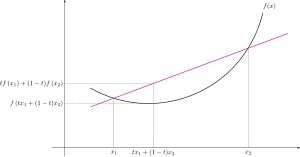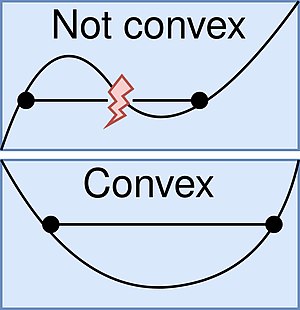



In mathematics, a real-valued function is called convex if the line segment between any two distinct points on the graph of the function lies above or on the graph between the two points. Equivalently, a function is convex if its epigraph (the set of points on or above the graph of the function) is a convex set. In simple terms, a convex function graph is shaped like a cup (or a straight line like a linear function), while a concave function's graph is shaped like a cap .
A twice-differentiable function of a single variable is convex if and only if its second derivative is nonnegative on its entire domain.[1] Well-known examples of convex functions of a single variable include a linear function (where is a real number), a quadratic function ( as a nonnegative real number) and an exponential function ( as a nonnegative real number).
Convex functions play an important role in many areas of mathematics. They are especially important in the study of optimization problems where they are distinguished by a number of convenient properties. For instance, a strictly convex function on an open set has no more than one minimum. Even in infinite-dimensional spaces, under suitable additional hypotheses, convex functions continue to satisfy such properties and as a result, they are the most well-understood functionals in the calculus of variations. In probability theory, a convex function applied to the expected value of a random variable is always bounded above by the expected value of the convex function of the random variable. This result, known as Jensen's inequality, can be used to deduce inequalities such as the arithmetic–geometric mean inequality and Hölder's inequality.
- ^ "Lecture Notes 2" (PDF). www.stat.cmu.edu. Retrieved 3 March 2017.





